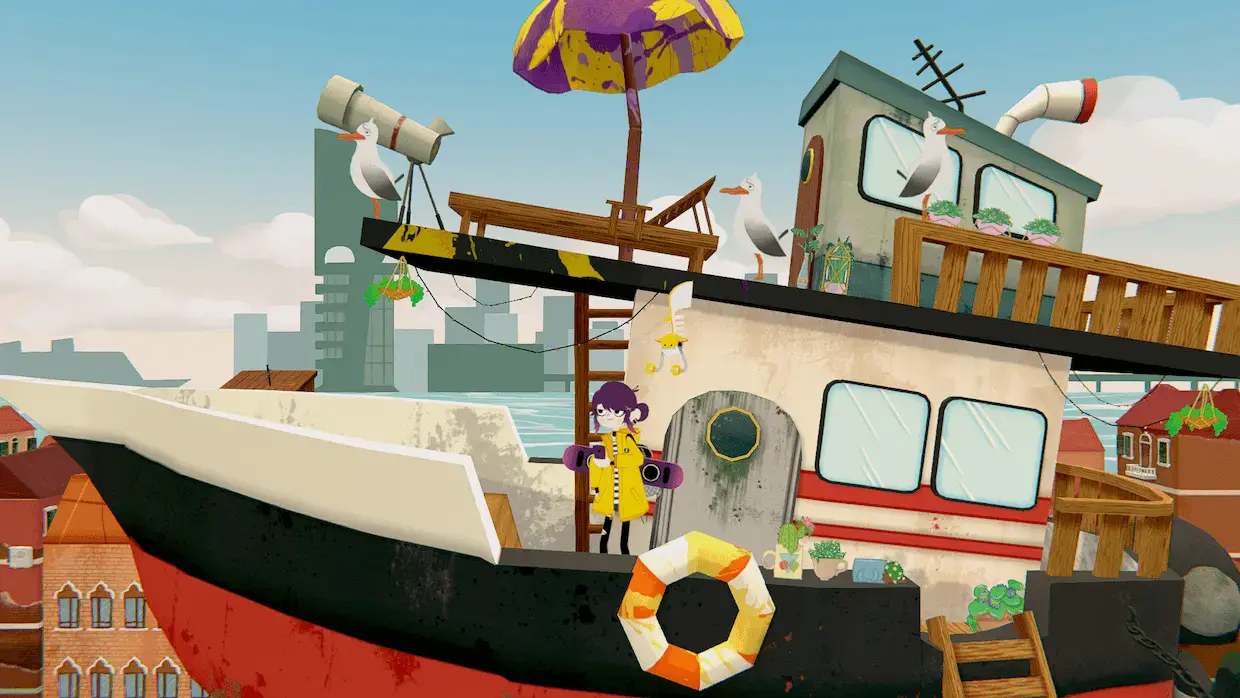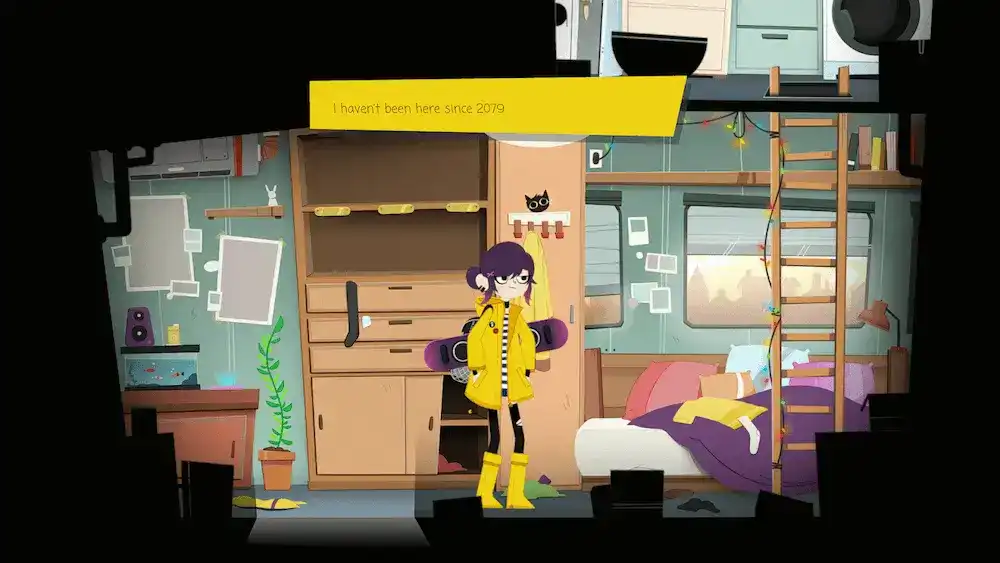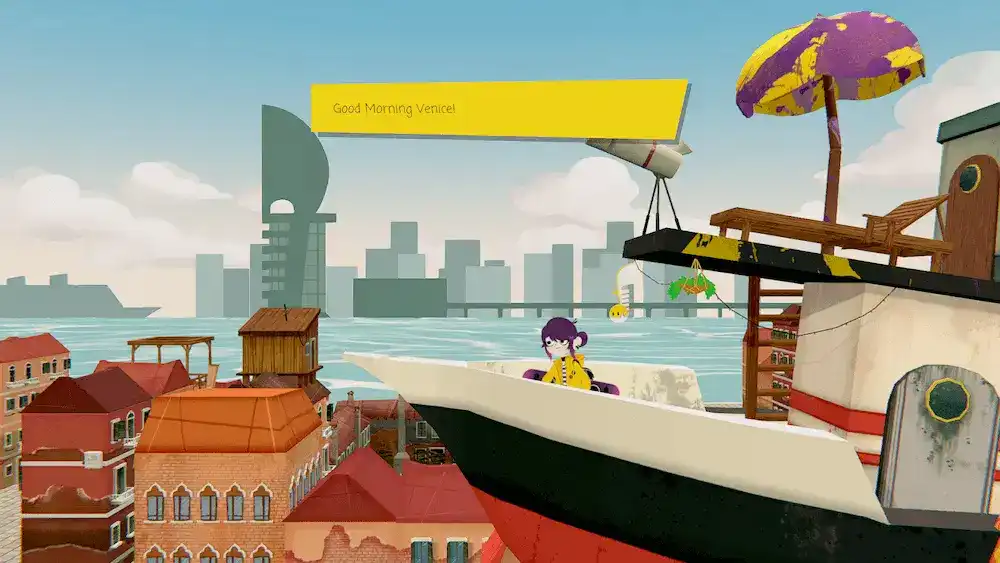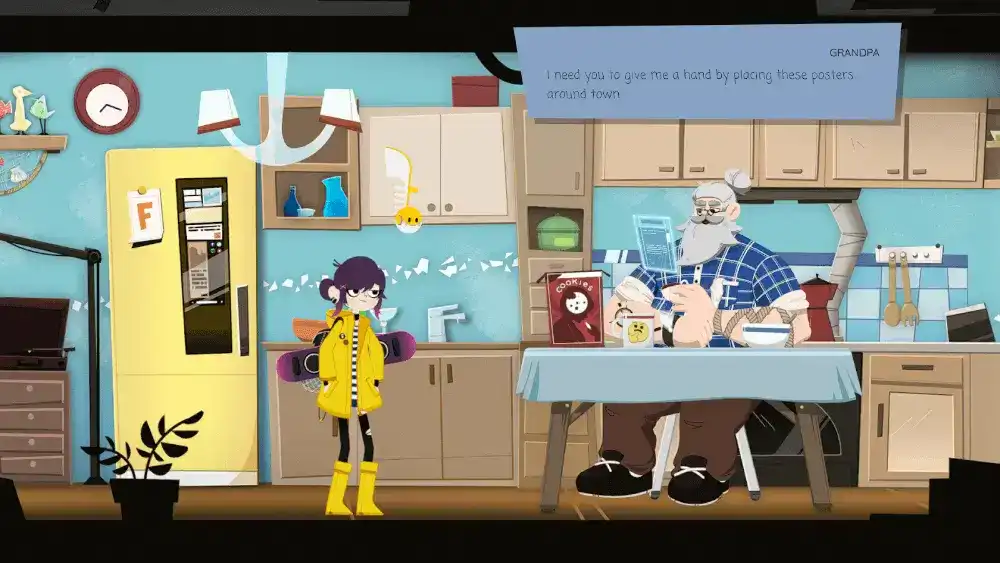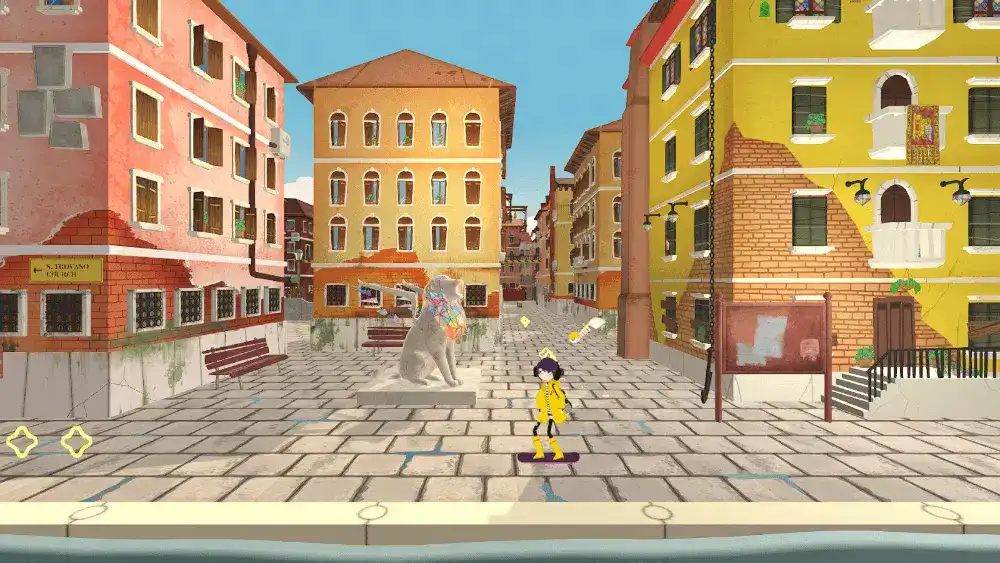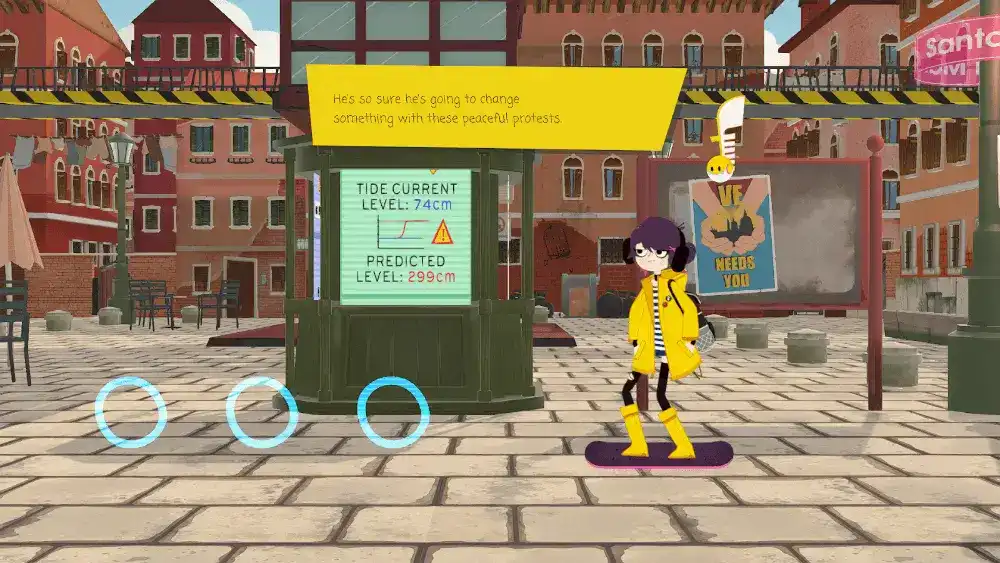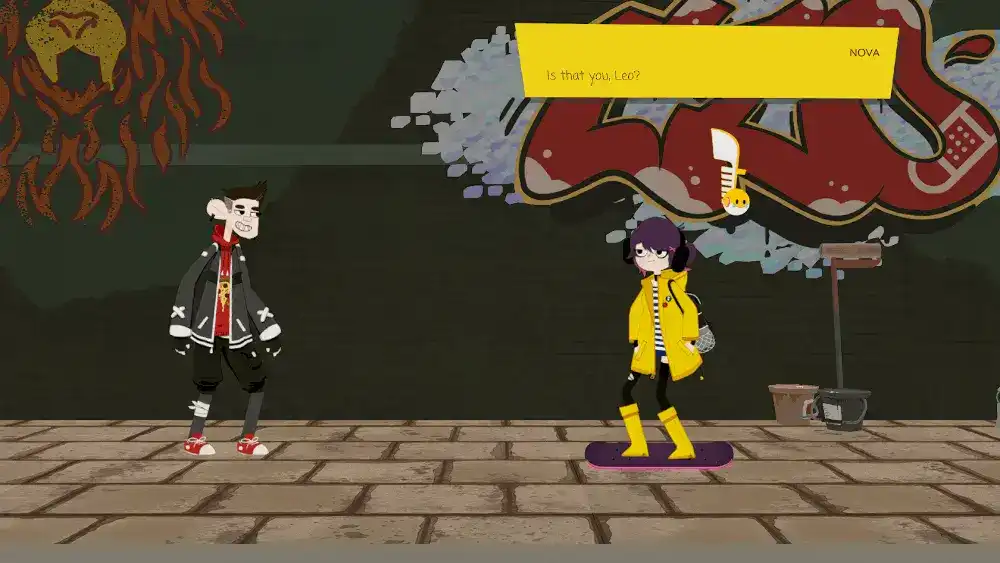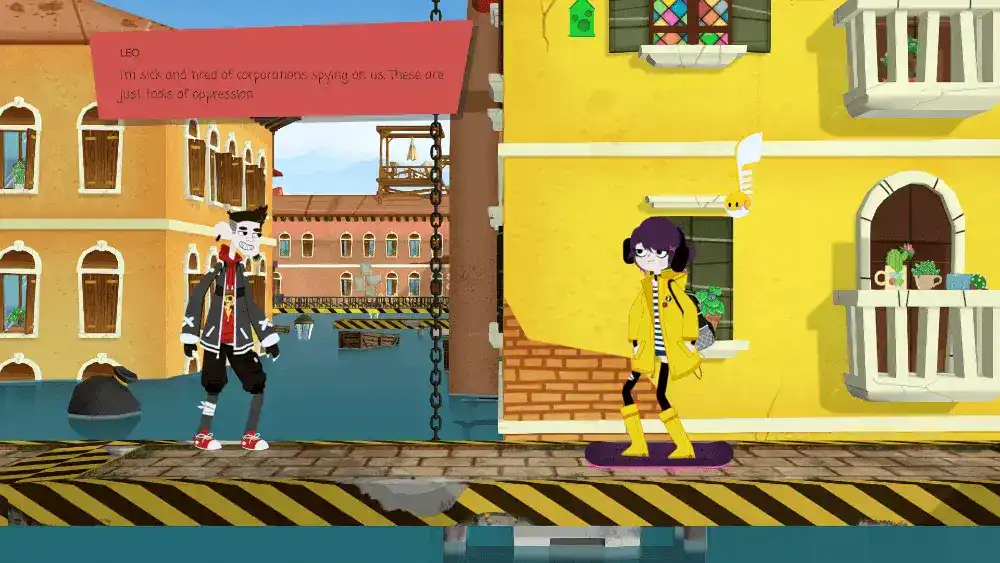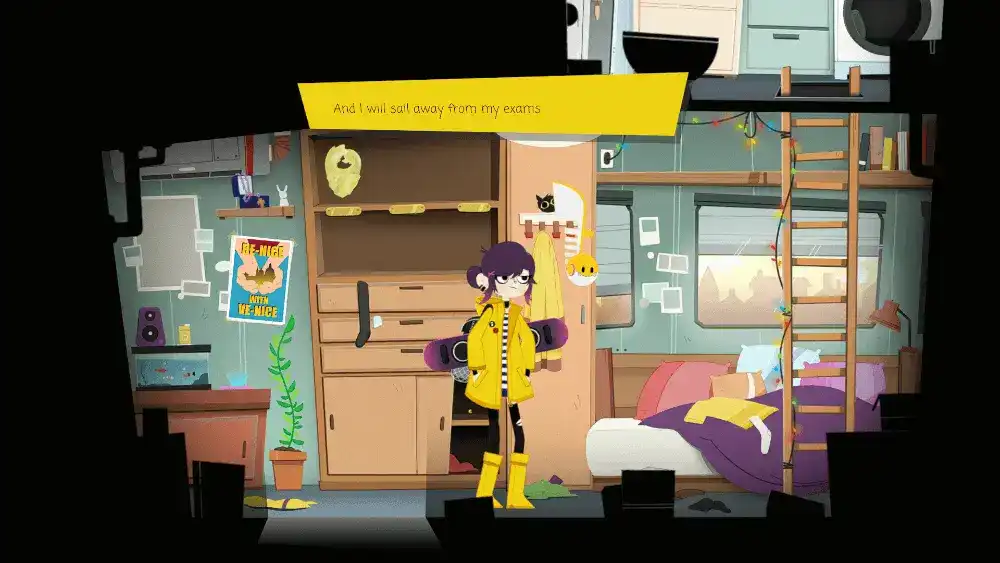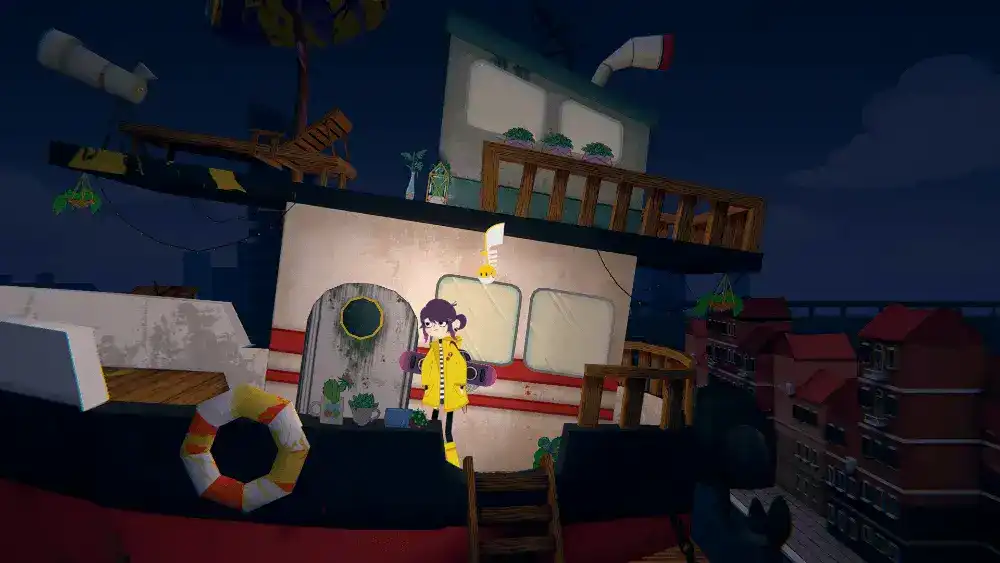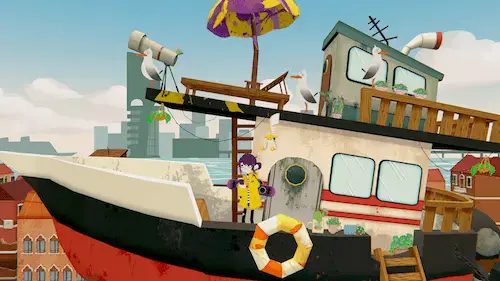I grew up in a relatively small city by the beach. No one had ever heard of my town while growing up, but if you had been there, you would know that it’s a beautiful but boring place to live. And that’s what my connection to Venice 2089 boils down to: it captures the small town spirit in its sleepy, free-spirited mood. As I was cruising on my hoverboard from one place to the next, stopping at whatever caught my interest, I felt like a teenager on a bicycle, enjoying the breeze again.
So Cool!
In Venice 2089, you play as Nova, a student who recently finished a round of exams and has come home for a small vacation. She hasn’t been home in about ten years, and it seems as though much has changed. I began the demo in Nova’s room, situated on the top of a boat: roomy, private, and extremely cool. I felt like I was living my old teenage paradise.
I then find Nova’s old flying drone (which miraculously still works) and leave the room to a wonderful view of future Venice. Half-sunken in the ocean and invaded by seagulls, the view is at once beautiful and grungy. Wood structures and dilapidated, old buildings are spread out between canals and surrounded by a large body of water.
After taking in the view, Nova walks into the living room of her home and meets her grandfather: a burly, hipster-y man who looks like a lumberjack. I felt as though I could understand him, even though he's somewhat juxtaposed by the more youthful protagonist. His relation to the 2020s is anchored in listening to lo-fi music and being a peaceful protester, and I could certainly connect with that. I felt that he makes for an ideal parent figure of the current generation: receptive, open to disagreement, and encouraging.
After some back and forth, he asks Nova to put up some posters around town for his meetup to save Venice from being swallowed up by the ocean. Nova doesn’t quite see the point herself, but she agrees to put up the posters and heads outside.
What’s The Future Like?
Finally, I got my hands on the hoverboard that I had seen from the trailers. Oh, the sweet freedom! When I saw this game, the hoverboard was one of the most eye-catching pieces of the gameplay, and it struck a chord in me. I had been in this kind of mood before, quite often when I had come back home from college: I wanted to unwind from exams, grab my bicycle and check out my favorite spots in the area for feelings of nostalgia.
Eager to explore her old town, Nova hops on her hoverboard, puts on a pair of slick headphones, and blasts off with her flying drone in tow, looking like the definition of cool. Lo-fi beats give the soundtrack a modern vibe (though it would be retro in 2089) that makes exploration a relaxing cruise through town.
I could walk through the town with the option to put my skateboard away, but I couldn't resist gliding down the streets of Venice on a hoverboard, doing tricks and grinds along the way. I also had control of my little drone, which could scare birds into giving me feathers or pick up distant items for me. The mechanics of this game are simple, yet fun to control. Going around corners shifts the perspective to the new street, with a slick transition that keeps the switch looking smooth.
For the most part, Venice 2089 keeps the “future” aspect to a respectable minimum. Aside from the hoverboard, drone, and Nova’s strange choice of clothing, there isn’t much different from a typical day in the life of a young person with nothing to do. One of the only indications is the overshadowing fact that Venice could sink and, in Nova’s words, “become the new Atlantis” any day now.
The Venetians of 2089
The first oddity about this futuristic Venice is its clear lack of people, save for the odd NPC. As Nova’s grandfather explained earlier, Venice’s population is rapidly declining because the townspeople fear that the city would completely sink into the ocean. In my opinion, the game had established that global warming would be a subject that had to be addressed, and nothing expressed it more than the citizens of Venice.
Only a few stubborn holdouts have stayed, like Nova’s grandfather, but not everyone really cares about preserving Venice. Very few people seemed to actually care about the rising tide and increasing environmental instability. Focusing the issue into the scope of a single town was a good idea because it handled the topic with subtlety.
However, it did raise an alarming question: Would people be so indifferent that they stop trying to address severe problems like rising water levels? For example, the ice cream vendor at the far end of the town doesn’t seem to notice Venice’s blatant flooding problems, operating a half-truck, half-boat shop that’s barely managing to stay afloat (economically). Remembering that Grandpa's rallies are nearly empty, I couldn't help but think that most people have chosen to accept their situation rather than solve it.
There are a few citizens with more fire in their bellies about the state of Venice. While putting up the posters over town, I was able to find some life in the city. In one particularly menacing alley was Leo, Nova’s delinquent childhood friend, busy spray painting walls with logos and even his own name. Leo’s graffiti carries messages of resistance and of standing up for Venice, though they aren’t specific about who is to blame.
I then returned to Nova’s home. In exchange for completing a few side quests, the trophy case in Nova’s room held some new shiny objects to marvel at. The next morning, a new Venice spread out in front of me. It was a high tide day, and the city was submerged in water. Funnily enough, Nova hardly reacts to the extreme water level eating up the city. It's such an ingrained, multi-generational issue that she doesn't even bat an eye towards it.
I could only see the top floors of a few tall buildings, the rest residing underneath the waves. Leo asked me to destroy a few cameras around town, which were later revealed to be federal government cameras.
The demo ends at the end of the second day, but I can only imagine how much further Venice sinks into the ground.
There's a Nova In All Of Us
Perhaps the real cherry on top of this game’s experience beyond its fantastic story concept, great art, and chill music, is Nova herself. She’s a fantastic character whose stream-of-consciousness I easily entered as soon as the game started. Extremely sardonic and chock-full of meme references, she is the product of our generation dialed up to eleven. She just can’t take anything very seriously, whether it be a scolding from grandpa to the ecological disaster that awaits Venice in the near future. Nova is jaded, sarcastic and overall cynical of most things around her, save for the simple joys of hoverboarding and eating ice cream.
I loved that Nova’s dialogue is filled references to meme culture. Venice 2089 is steadfast that memes will live on well into the future. I’m sure that Grandpa passed the torch to Nova himself, as he even makes a “General Kenobi” reference on the second day. I think it creates a crucial bridge from 2020 to 2089 that ties our current world with the futuristic Venice of the game.
Although she’s sarcastic and a meme queen, Nova means well and has virtues that make her extremely likable. Although their opinions differ, Nova still cares about her grandfather and willfully helps him with errands around town. They have a solid relationship built on mutual trust, and Nova really cherishes her grandpa. When she talks to others in town, it’s never from a sense of superiority: she seems to view everyone equally, even though others in the town do not. The few citizens in town blame each other for Venice’s problems, but Nova never approaches a person with anger; she hears them out. She’s a bit cynical, yes, but a bad person she is not.
Into The Sunset
Venice 2089 is a romp through small town suburbia that taps into the feelings of youth in revolt, the small town blues, and modern meme culture. Check out the demo and look out for the full release in the future. Who knows, there might even be a way to save the town — but for now, hop on your hoverboard and ride out the waning days of Venice in style.
